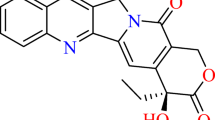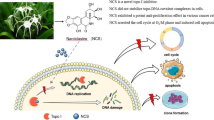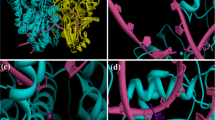Abstract
Curcumin, a golden yellow pigment present in the spice turmeric, has pleiotropic chemopreventive and therapeutic active compound against many diseases including cancer. It has been reported that curcumin acts as a topoisomerase II inhibitor and it was found that even concentration of 50 µM of curcumin in vitro is active in a similar fashion as etoposide (antineoplastic agent). Topoisomerases (type I and type II) are enzymes that regulate the overwinding or underwinding of DNA by cutting the phosphate bond of one or two strands of DNA, respectively. Topoisomerase II was selected as target, since it affects both strands of DNA. The present in silico study about designing curcumin analogues as better inhibitors of topoisomerase vis-à-vis curcumin is based on ADME filtering and docking simulation using Schrödinger suite. The docking simulation result suggested that out of 1000 designed curcumin analogues using ligbuilder tool and curcumin as a lead, 293 screened analogues show good binding affinity at the active site of Human DNA topoisomerase II in comparison to known drug Salvicine. The top five analogues with best binding affinity was shown by ligand1_826, ligand1_758, ligand1_976, ligand1_956 and ligand1_827 with glide scores − 16.70, − 16.03, − 15.45, − 15.43 and − 15.09, respectively. Therefore it is possible that screened curcumin analogues can be used as lead molecules for screening of ligand database and future chemopreventive agents.



Similar content being viewed by others
References
ACD/ChemSketch version 8.0 (2006) Advanced Chemistry Development, Inc., Toronto ON, canada, http://www.acdlabs.com. Accessed 5 July 2014
Aggarwal BB, Kumar A, Bharti AC (2003) Anticancer potential of curcumin: preclinical and clinical studies. Anticancer Res 23(1A):363–398
Berman HM, Westbrook J, Feng Z, Gilliland G, Bhat TN, Weissig H, Shindyalov IN, Bourne PE (2000) The protein data bank. Nucleic Acids Res 28:235–242
Bharti AC, Donato N, Singh S, Aggarwal BB (2003) Curcumin (diferuloylmethane) down-regulates the constitutive activation of nuclear factor-kappa B and Ikappa B alpha kinase in human multiple myeloma cells, leading to suppression of proliferation and induction of apoptosis. Blood 101(3):1053–1062
Bradley G, Juranka PF, Ling V (1988) Mechanism of multidrug resistance. Biochim Biophys Acta 948(1):87–128
Cattan AR, Levett D, Douglas EA, Middleton PG, Taylorm PR (1996) Method for quantifying expression of functionally active topoisomerase II in patients with leukaemia. J Clin Pathol 49(10):848–852
Chao-Xin H, Zhi-Li Z, Bing X, Jin-Gui M, Mei-Yu G, Li-Ping L, Hua-Liang J, Jian D (2006) Salvicine functions as novel topoisomerase II poison by binding to ATP pocket. Mol Pharmacol 70:1593–1601
Friesner RA, Murphy RB, Repasky MP, Frye LL, Greenwood JR, Halgren TA, Sanschagrin PC, Mainz DT (2006) Extra precision glide: docking and scoring incorporating a model of hydrophobic enclosure for protein-ligand complexes. J Med Chem 49:6177–6196
Gadakar PK, Phukan S, Dattatreya P, Balaji VN (2007) Pose prediction accuracy in docking studies and enrichment of actives in the active site of GSK-3β. J Chem Inf Model 47:1446–1459
Halgren T (2009) Identifying and characterizing binding sites and assessing druggability. J Chem Inf Model 49:377–389
Hanahan D, Weinberg RA (2000) The hallmarks of cancer. Cell 100(1):57–70
Holy JM (2002) Curcumin disrupts mitotic spindle structure and induces micronucleation in MCF-7 breast cancer cells. Mutation Res 518(1):71–84
Jemal A, Bray F, Center MM, Ferlay J, Ward E, Forman D (2011) Global cancer statistics. CA Cancer J Clin 61(2):69–90
Karunagaran D, Rashmi R, Kumar TR (2005) Induction of apoptosis by curcumin and its implications for cancer therapy. Curr Cancer Drug Targets 5(2):117–129
Keserwani RK, Kesharwani RK, Vyas N, Jain S, Raghuvanshi R, Sharma AK (2010a) Nutraceutical and functional food as future food: a review. Der Pharmacia Lettre 2010: 2(1):106–116
Keserwani RK, Kesharwani RK, Vyas N, Chadokar A (2010b) Nutritional supplements: an overview. Int J Curr Pharm Rev Res 1(1):59–75
Kesharwani RK, Misra K (2011) Prediction of binding site for curcuminoids at human topoisomerase II α protein; an in silico approach. Curr Sci 101(8):1060–1064
Kesharwani RK, Singh DV, Misra K (2013) Computation-based virtual screening for designing novel antimalarial drugs by targeting falcipain-III: a structure-based drug designing approach. J Vector Borne Dis 50:93–102
Kesharwani RK, Srivastava V, Singh P, Rizvi SI, Adeppa K, Misra K (2015) A novel approach for overcoming drug resistance in breast cancer chemotherapy by targeting new synthetic curcumin analogues against aldehyde dehydrogenase 1 (ALDH1A1) and glycogen synthase kinase-3 β (GSK-3β). Appl Biochem Biotechnol. https://doi.org/10.1007/s12010-015-1696-x
Maestro (v7.0.113) (2005) A unified interface for all Schrodinger products, developed and marketed by Schrodinger, LLC. NY http://www.schrodinger.com. Accessed 5 July 2014
Martín-Cordero C, López-Lázaro M, Gálvez M, Ayuso MJ (2003) Curcumin as a DNA topoisomerase II poison. J Enzyme Inhib Med Chem18(6):505–509
Martin-Richard M, Muñoz M, Albanell J, Colomo L, Bellet M, Rey MJ, Tabernero J, Alonso C, Cardesa A, Gascon P, Fernandez PL (2004) Serial topoisomerase II expression in primary breast cancer and response to neoadjuvant anthracycline-based chemotherapy. Oncology 66(5):388–394
McDonald IK, Thornton JM (1994) Satisfying hydrogen bonding potential in proteins. JMB 238:777–793
Mueller-Planitz F, Herschlag D (2007) DNA topoisomerase II selects DNA cleavage sites based on reactivity rather than binding affinity. Nucleic Acids Res 35(11):3764–3773
Poma P, Notarbartolo M, Labbozzetta M, Maurici A, Carina V, Alaimo A et al (2007) The antitumor activities of curcumin and of its isoxazole analogue are not affected by multiple gene expression changes in an MDR model of the MCF-7 breast cancer cell line: analysis of the possible molecular basis. Int J Mol Med 20(3):329–335
Ravindran J, Prasad S, Aggarwal BB (2009) Curcumin and cancer cells: how many ways can curry kill tumor cells selectively? AAPS J 11(3):495–510
Ruby AJ, Kuttan G, Dinesh Babu K, Rajasekharan KN, Kuttan R (1995) Anti-tumour and antioxidant activity of natural curcuminoids. Cancer Lett 94(1):79–83
Singh DB, Gupta MK, Kesharwani RK, Misra K (2013) Comparative docking and ADMET study of some curcumin derivatives and herbal congeners targeting b-amyloid. Netw Model Anal Health Inform Bioinform (2013) 2:13–27. https://doi.org/10.1007/s13721-012-0021-7
Singh DV, Agarwal S, Kesharwani RK, Misra K (2014) 3D QSAR and pharmacophore study of curcuminoids and curcumin analogs: interaction with thioredoxin reductase, interdisciplinary sciences. Comput Life Sci 5(4):286–295
Singh P, Kesharwani RK, Misra K, Rizvi SI (2015) The modulation of erythrocyte Na+/K+-ATPase activity by curcumin. J Adv Res. https://doi.org/10.1016/j.jare.2014.12.007
Sun A, Lu YJ, Hu H, Shoji M, Liotta DC, Snyder JP (2009) Curcumin analog cytotoxicity against breast cancer cells: exploitation of a redox-dependent mechanism. Bioorg Med Chem Lett 19(23):6627–6631. https://doi.org/10.1016/j.bmcl.2009.10.023
Thomsen R, Christensen MH (2006) MolDock: a new technique for high-accuracy molecular docking. J Med Chem 49(11):3315–3321
Tripathi A, Singh DV, Kesharwani RK, Misra K (2014) P-Glycoprotein: a critical comparison of models depicting mechanism of drug efflux and role of modulators. Proc Natl Acad Sci India Sect B Biol. https://doi.org/10.1007/s40011-014-0405-9
Upadhyay J, Kesharwani RK, Misra K (2009) Comparative study of antioxidants as cancer preventives through inhibition of HIF-1 alpha activity. Bioinformation 4(6):233–236
Upadhyaya J, Kesharwani RK, Misra K (2009) Metabolism, pharmacokinetics and bioavailability of ascorbic acid; synergistic effect with tocopherols and curcumin. J Comput Intell Bioinform 2(1):77–84
Wang JC (2002) Cellular roles of DNA topoisomerases: a molecular perspective. Nat Rev Mol Cell Biol 3(6):430–440
Wang R, Gao Y, Lai L (2000) Ligbuilder: a multiple-purpose program for structure-based drug design. J Mol Model 6:498–516
Waris G, Ahsan H (2006) Reactive oxygen species: role in the development of cancer and various chronic conditions. J Carcinog 5:14
Wei H, Ruthenburg AJ, Bechis SK, Verdine GL (2005) Nucleotide-dependent domain movement in the ATPase domain of a human type IIA DNA topoisomerase. J Biol Chem 280(44):37041–37047
Acknowledgements
Rajesh Kr. Kesharwani acknowledge the support of Indian council of medical research (ICMR), New Delhi, India for providing Senior Research Fellowship.
Author information
Authors and Affiliations
Corresponding author
Ethics declarations
Conflict of interest
The author confirms that this article content has no conflict of interest.
Electronic supplementary material
Below is the link to the electronic supplementary material.
Rights and permissions
About this article
Cite this article
Kesharwani, R.K., Singh, D.B., Singh, D.V. et al. Computational study of curcumin analogues by targeting DNA topoisomerase II: a structure-based drug designing approach. Netw Model Anal Health Inform Bioinforma 7, 15 (2018). https://doi.org/10.1007/s13721-018-0179-8
Received:
Revised:
Accepted:
Published:
DOI: https://doi.org/10.1007/s13721-018-0179-8




